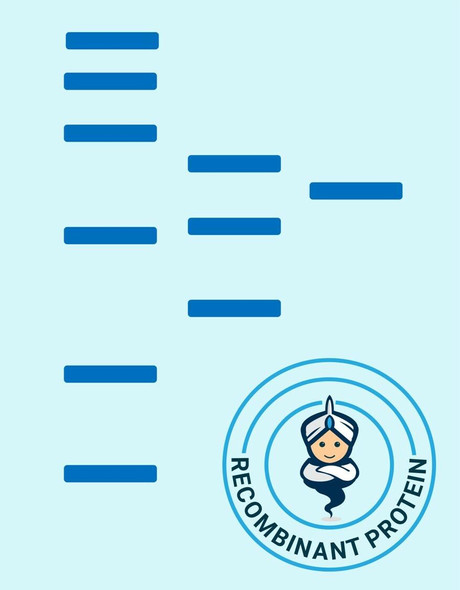Description
| Product Name: | Human ADAM10 Recombinant Protein |
| Product Code: | RPPB2700 |
| Size: | 10µg |
| Species: | Human |
| Target: | ADAM10 |
| Synonyms: | Kuz, AD10, MADM, CD156c, HsT18717, ADAM metallopeptidase domain 10, A disintegrin and metalloproteinase domain 10, Mammalian disintegrin-metalloprotease, Kuzbanian protein homolog, CDw156, ADAM 10, ADAM10. |
| Source: | Escherichia Coli |
| Physical Appearance: | Sterile Filtered colorless solution. |
| Formulation: | The ADAM10 solution contains 20mM Tris (pH 8), 1mM EDTA and 50% Glycerol. |
| Stability: | Store at 4°C if entire vial will be used within 2-4 weeks.Store, frozen at -20°C for longer periods of time. For long term storage it is recommended to add a carrier protein (0.1% HSA or BSA).Avoid multiple freeze-thaw cycles. |
| Purity: | Greater than 95.0% as determined by SDS-PAGE. |
ADAM10 is part of the ADAM family which are cell surface proteins with a distinctive structure possessing both potential adhesion and protease domains. ADAM10 cleaves many proteins including TNF-alpha and E-cadherin. ADAM10 cleaves the membrane-bound precursor of tnf-alpha at 76- ala-|-val-77 to its mature soluble form. ADAM10 is in charge for the proteolytic release of several other cell-surface proteins, including ephrin-a2 and for constitutive and regulated alpha-secretase cleavage of amyloid precursor protein. ADAM10 is involved in the normal cleavage of the cellular prion protein. ADAM10 is involved in the cleavage of the adhesion molecule l1 at the cell surface and in the release of membrane vesicles, suggesting a vesicle-based protease activity. ADAM10 controls the proteolytic processing of notch and mediates lateral inhibition during neurogenesis.
ADAM10 extracellular domain minus the signal peptide and pro-sequence Human Recombinant fused to N-terminal His-Tag produced in E.Coli is a single, non-glycosylated polypeptide chain containing 459 amino acids (214-672) and having a molecular mass of 55.089kDa.
| UniProt Protein Function: | ADAM10: Cleaves the membrane-bound precursor of TNF-alpha at '76-Ala-|-Val-77' to its mature soluble form. Responsible for the proteolytical release of soluble JAM3 from endothelial cells surface. Responsible for the proteolytic release of several other cell-surface proteins, including heparin-binding epidermal growth- like factor, ephrin-A2 and for constitutive and regulated alpha- secretase cleavage of amyloid precursor protein (APP). Contributes to the normal cleavage of the cellular prion protein. Involved in the cleavage of the adhesion molecule L1 at the cell surface and in released membrane vesicles, suggesting a vesicle-based protease activity. Controls also the proteolytic processing of Notch and mediates lateral inhibition during neurogenesis. Responsible for the FasL ectodomain shedding and for the generation of the remnant ADAM10-processed FasL (FasL APL) transmembrane form. Also cleaves the ectodomain of the integral membrane proteins CORIN and ITM2B. May regulate the EFNA5-EPHA3 signaling. |
| UniProt Protein Details: | Protein type:Cell adhesion; Cell surface; EC 3.4.24.81; Membrane protein, integral; Motility/polarity/chemotaxis; Protease; Vesicle Chromosomal Location of Human Ortholog: 15q21.3 Cellular Component: cell surface; cytoplasm; focal adhesion; Golgi apparatus; Golgi-associated vesicle; membrane; nucleus; plasma membrane Molecular Function:endopeptidase activity; metalloendopeptidase activity; metallopeptidase activity; protein binding; protein homodimerization activity; protein kinase binding Biological Process: constitutive protein ectodomain proteolysis; ephrin receptor signaling pathway; extracellular matrix disassembly; in utero embryonic development; membrane protein ectodomain proteolysis; monocyte activation; negative regulation of cell adhesion; neutrophil degranulation; Notch receptor processing; Notch signaling pathway; PMA-inducible membrane protein ectodomain proteolysis; positive regulation of cell growth; positive regulation of cell migration; positive regulation of cell proliferation; protein amino acid phosphorylation Disease: Alzheimer Disease 18; Reticulate Acropigmentation Of Kitamura |
| NCBI Summary: | Members of the ADAM family are cell surface proteins with a unique structure possessing both potential adhesion and protease domains. This gene encodes and ADAM family member that cleaves many proteins including TNF-alpha and E-cadherin. Alternate splicing results in multiple transcript variants encoding different proteins that may undergo similar processing. [provided by RefSeq, Feb 2016] |
| UniProt Code: | O14672 |
| NCBI GenInfo Identifier: | 29337031 |
| NCBI Gene ID: | 102 |
| NCBI Accession: | O14672.1 |
| UniProt Secondary Accession: | O14672,Q10742, Q92650, B4DU28, |
| UniProt Related Accession: | O14672 |
| Molecular Weight: | 84kDa |
| NCBI Full Name: | Disintegrin and metalloproteinase domain-containing protein 10 |
| NCBI Synonym Full Names: | ADAM metallopeptidase domain 10 |
| NCBI Official Symbol: | ADAM10�� |
| NCBI Official Synonym Symbols: | RAK; kuz; AD10; AD18; MADM; CD156c; CDw156; HsT18717�� |
| NCBI Protein Information: | disintegrin and metalloproteinase domain-containing protein 10 |
| UniProt Protein Name: | Disintegrin and metalloproteinase domain-containing protein 10 |
| UniProt Synonym Protein Names: | CDw156; Kuzbanian protein homolog; Mammalian disintegrin-metalloprotease; CD_antigen: CD156c |
| Protein Family: | Disintegrin and metalloproteinase domain-containing protein |
| UniProt Gene Name: | ADAM10�� |






